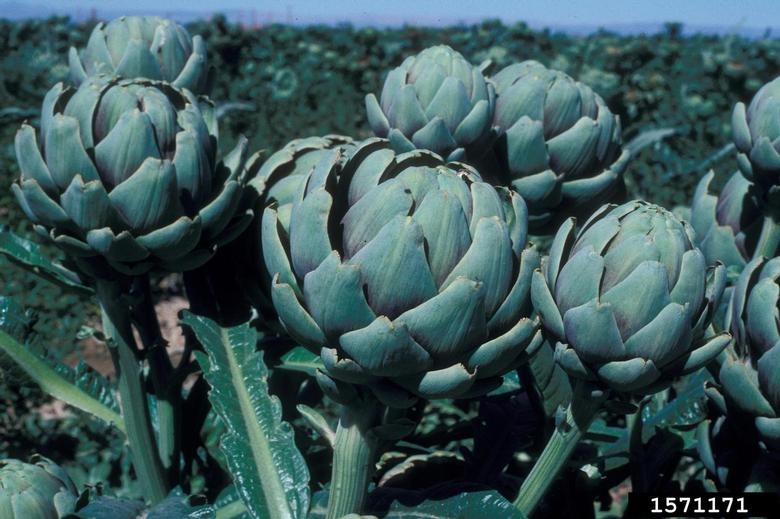 Growing Artichokes - April 5, 2017 Jeff Schalau, Agent, Agriculture & Natural Resources University of Arizona Cooperative Extension, Yavapai County While many gardeners would consider the globe artichoke to be more appropriate for milder, coastal climates, I know several gardeners that have successfully grown artichokes in Yavapai County. These perennial plants can be grown for both for edible flower buds and showy garden flowers. Historically, artichokes originated in southern Europe where they were cultivated since Roman times. They were brought to California by Spanish explorers. Artichokes are grown for the soft fleshy receptacle and thickened bases of the bracts of the flower heads. The artichoke is a cool weather perennial thistle plant in the Asteraceae (sunflower) family. Artichoke plants have long, arching leaves that are silver-green in color. A mature plant is four feet and six feet wide. Edible globe artichokes are harvested in the bud stage before the flower opens. The open flowers are purple in color and will grow up to a diameter of 7 inches if not harvested. The yield from the three or four plants should be quite enough for a small family's enjoyment. And once established an artichoke plant can remain productive for four to seven years. Globe artichokes prefer full sun and deep, fertile, well-drained soils high in organic matter. In limy areas, you may also add soil sulfur to temporarily lower alkalinity (pH). After the soil has been amended with compost, a small amount of phosphorus fertilizer should also be placed about 8-10 inches deep to make it readily available to plant roots. Artichokes also require lots of moisture for maximum growth. They can survive drought, but will not produce well without consistent soil moisture. Artichoke plants are generally large and spiny. Most people purchase root crowns which will usually produce a crop of artichoke buds the first year after planting. Artichokes can also be grown from seed, but you may notice greater variability in production and quality with seed grown plants. Artichoke should be planted 3-4 weeks before the frost-free date for your area because it requires cool temperatures to initiate the flower stalk. Plant each crown or transplant 18 inches apart in the row, with rows 2-3 feet apart. Water frequently after transplanting to ensure good root and shoot growth. Maintain healthy vigorous growth during the spring and summer to ensure that artichoke produces for a long time. Established artichoke plants produce several stalks and each stalk bears several flowers. For edible buds, harvest them before they open. In our climate, pay careful attention to ripening flower buds and harvest them before they start to open or become tough. If left to flower, the plant will produce a large purple thistle which may be dried and used in arrangements. If you harvest all the flowering heads, artichokes may send up a second crop of flowers in the fall. In areas that receive freezing temperatures, artichoke plants should be headed back to 12 inches and covered with deep mulch of straw or leaves prior to winter. Uncover in late spring and inspect the crowns for signs of life. If freeze damage occurs, remove the affected material the following spring or replant with new crowns. If plants have survived, then remember to lightly side dress a balanced fertilizer (i.e. 10-10-10) during the growing season. Artichoke plants should be divided every 3-5 years. Prior to replanting, the soil should be prepared again as described above. The variety ‘Green Globe’ is commonly grown in California but may not be the best suited variety for Arizona’s summer heat. The variety ‘Imperial Star’ was developed by California Cooperative Extension and has shown broad climatic adaptability. It is currently being grown in southern California coastal regions, and in desert areas in California and Arizona. I recommend trying 'Imperial Star'. Aphids are often attracted to globe artichoke plants and can be easily managed by spraying with a hard stream of water from the hose. Wash off with water occasionally as needed early in the day. Check for evidence of natural enemies such as gray-brown or bloated parasitized aphids and the presence of alligator-like larvae of lady beetles and lacewings. I hope this has inspired you to consider growing a few artichoke plants in your garden or landscape! I’ve also included additional information below. Follow the Backyard Gardener on Twitter – use the link on the BYG website. If you have other gardening questions, call the Master Gardener help line in the Camp Verde office at 928-554-8992 or e-mail us at verdevalleymg@gmail.com and be sure to include your name, address and phone number. Find past Backyard Gardener columns or provide feedback at the Backyard Gardener web site: http://cals.arizona.edu/yavapai/anr/hort/byg/.  Additional Resources Artichoke in the Garden Utah State University Cooperative Extension extension.usu.edu/files/publications/factsheet/HG-2003-03.pdf Growing Artichokes Texas A & M Agrilife Extension Extension agrilifeextension.tamu.edu/browse/featured-solutions/gardening-landscaping/artichokes/ Peel Off the Layers of Growing Artichokes Oregon State University Extension Service extension.oregonstate.edu/gardening/2016/02/peel-layers-growing-artichokes |